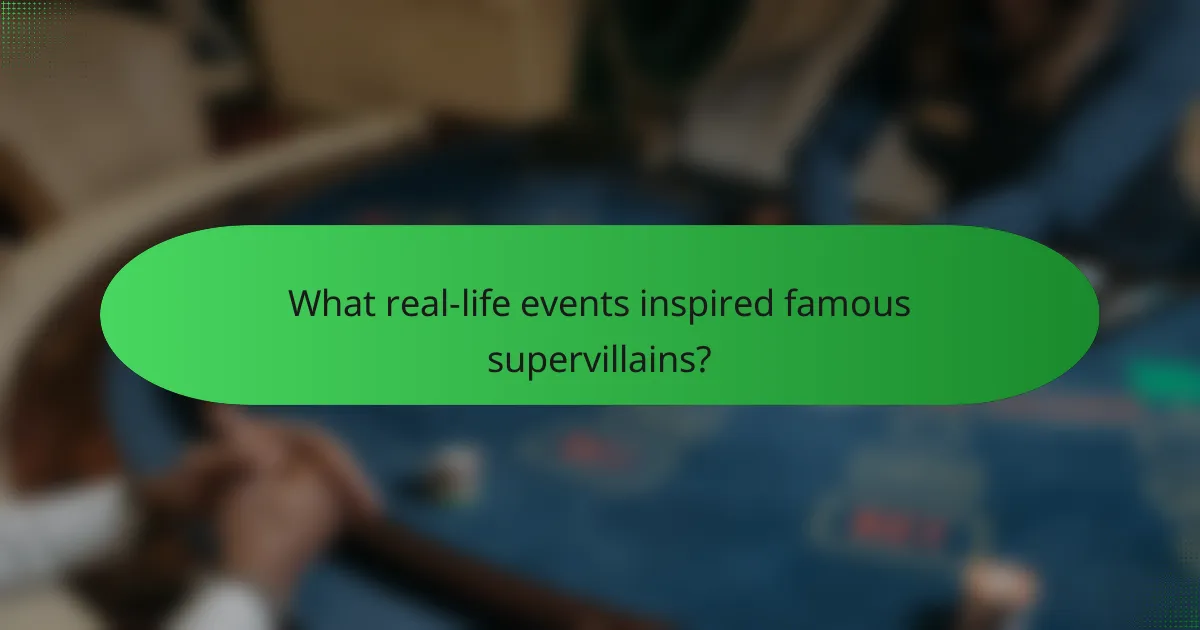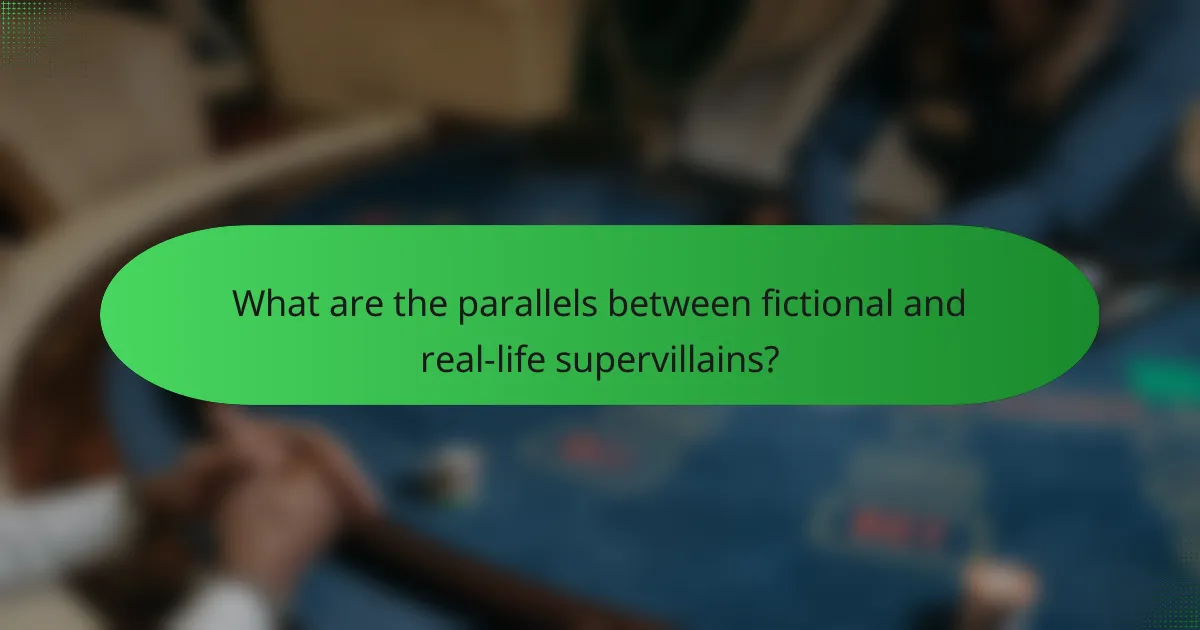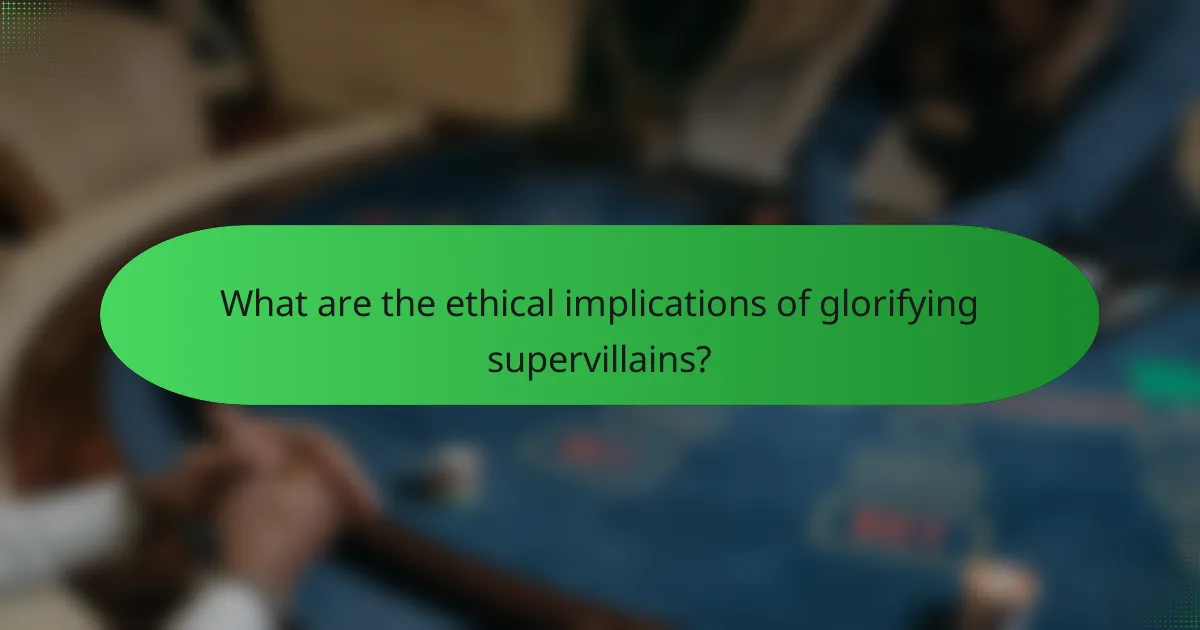Supervillains in history often serve as reflections of real-life events and figures, embodying the darker facets of human nature. By examining the actions of notorious criminals and dictatorial regimes, we gain insight into the archetypes of evil that shape our understanding of power, corruption, and justice. These historical narratives not only highlight the consequences of unchecked authority but also provide valuable lessons on preventing similar occurrences in the future.

What real-life events inspired famous supervillains?
Many famous supervillains draw inspiration from real-life events and figures, reflecting the darker aspects of human nature. Historical atrocities, dictatorial regimes, and notorious criminals have all contributed to the creation of these larger-than-life characters.
Historical figures like Adolf Hitler
Adolf Hitler serves as a chilling example of a historical figure whose actions inspired numerous supervillains. His rise to power, marked by extreme nationalism and genocide, illustrates how a single individual can manipulate masses and instigate widespread fear and destruction.
Villains inspired by Hitler often embody traits such as charismatic leadership combined with ruthless ambition. They may utilize propaganda and fear tactics to maintain control, mirroring the strategies employed during the Nazi regime.
Dictators such as Joseph Stalin
Joseph Stalin’s reign over the Soviet Union exemplifies the archetype of a tyrannical dictator, inspiring various fictional villains. His oppressive regime, characterized by purges and forced labor camps, highlights the potential for absolute power to corrupt absolutely.
Supervillains modeled after Stalin often exhibit paranoia and a willingness to eliminate perceived threats, reflecting the brutal tactics used to consolidate power. They may also engage in widespread surveillance and propaganda to manipulate public perception.
Criminal masterminds like Al Capone
Al Capone, a notorious American gangster, represents the archetype of the criminal mastermind. His involvement in organized crime during the Prohibition era showcases how illegal enterprises can thrive under charismatic leadership and strategic ruthlessness.
Villains inspired by Capone often operate within the shadows, using cunning and intimidation to achieve their goals. They might engage in illicit activities while maintaining a public persona that masks their true nature, highlighting the duality of their existence.

How have historical supervillains shaped modern perceptions?
Historical supervillains have significantly influenced modern perceptions by serving as archetypes for evil and moral conflict. Their actions and narratives often shape societal views on power, corruption, and justice, reflecting deeper fears and aspirations.
Influence on pop culture and media
Historical supervillains have inspired countless characters in movies, comics, and literature, creating a lasting impact on pop culture. Figures like Adolf Hitler and Joseph Stalin have been depicted in various media as embodiments of tyranny, influencing how audiences understand villainy.
These portrayals often exaggerate traits for dramatic effect, yet they resonate with audiences, reinforcing stereotypes about power and malevolence. For example, films like “V for Vendetta” draw parallels between fictional villains and real-life dictators, prompting viewers to reflect on authority and rebellion.
Impact on political discourse
The legacy of historical supervillains shapes political discourse by framing debates around morality and ethics in governance. Leaders often invoke the names of notorious figures to criticize opponents, suggesting that their policies could lead to tyranny or oppression.
This rhetorical strategy can polarize discussions, as invoking a supervillain’s legacy may evoke strong emotional responses. For instance, labeling a political adversary as a “modern-day Hitler” can shift the conversation from policy to moral outrage, complicating constructive dialogue.

What lessons can we learn from historical supervillains?
Historical supervillains teach us about the dangers of unchecked power and the consequences of authoritarianism. By analyzing their actions and the societal conditions that allowed them to rise, we can identify warning signs and strategies to prevent similar occurrences in the future.
Understanding the psychology of power
The psychology of power reveals how individuals can become corrupted by authority. Many historical supervillains exhibited traits such as narcissism and a lack of empathy, which allowed them to manipulate others and justify their harmful actions. Recognizing these traits in leaders can help societies remain vigilant against potential abuses of power.
Power can create a disconnect between leaders and the populace, leading to decisions that prioritize personal gain over the common good. It is crucial for citizens to engage in active oversight and hold leaders accountable to mitigate the risks associated with concentrated power.
Recognizing the signs of authoritarianism
Authoritarianism often emerges gradually, marked by specific warning signs such as the erosion of democratic norms, suppression of dissent, and manipulation of media. These indicators can serve as red flags for societies to take action before it is too late. For example, when a government begins to limit free speech or undermine judicial independence, it may signal a shift towards authoritarian rule.
To combat authoritarian tendencies, citizens should remain informed and engaged in political processes. Building coalitions and fostering open dialogue can help counteract the rise of oppressive regimes. It is essential to promote education about civic rights and responsibilities to empower individuals to recognize and resist authoritarianism effectively.

How do supervillains reflect societal fears?
Supervillains often embody the collective anxieties and fears of society, serving as exaggerated representations of real-world issues. These characters highlight societal concerns, from economic disparity to technological advancements, prompting reflection on the underlying problems that give rise to such fears.
Representation of economic inequality
Supervillains frequently symbolize the growing divide between the wealthy and the impoverished. Characters like Lex Luthor or Scrooge McDuck illustrate how extreme wealth can lead to moral corruption and a disregard for the less fortunate, reflecting societal fears about economic injustice.
In many narratives, the supervillain’s wealth enables them to wield power and influence, often at the expense of the common person. This dynamic serves as a critique of capitalism, prompting audiences to consider the implications of unchecked economic power and the potential for exploitation.
Embodiment of technological anxieties
The rise of supervillains often coincides with advancements in technology, showcasing fears about its misuse. Characters like Ultron or Skynet represent the potential dangers of artificial intelligence and automation, emphasizing concerns about loss of control and ethical dilemmas in technological development.
These narratives encourage critical thinking about the implications of technological progress, urging society to consider regulations and ethical standards. As technology continues to evolve, the portrayal of supervillains can serve as a cautionary tale about the responsibilities that come with innovation.

What are the parallels between fictional and real-life supervillains?
Fictional supervillains often draw inspiration from real-life figures, reflecting societal fears and moral dilemmas. Both types of villains share similar traits and motivations, which can reveal insights into human behavior and the consequences of power.
Comparative analysis of characters
Fictional supervillains like Lex Luthor and the Joker often embody traits seen in historical figures such as Adolf Hitler and Joseph Stalin. These characters and individuals demonstrate how charisma, intelligence, and a desire for control can lead to catastrophic consequences. The methods they employ, whether through manipulation, violence, or propaganda, highlight the darker aspects of ambition and authority.
For instance, Lex Luthor’s obsession with defeating Superman mirrors Hitler’s need to assert dominance over perceived threats. Both characters illustrate how personal vendettas can escalate into larger conflicts, affecting countless lives.
Common traits and motivations
Common traits among both fictional and real-life supervillains include a thirst for power, a sense of superiority, and a willingness to harm others for personal gain. These motivations often stem from deep-seated insecurities or past traumas, driving them to seek validation through domination.
Additionally, many supervillains exhibit a lack of empathy, which allows them to justify their actions. This detachment can be seen in figures like Osama bin Laden, whose extremist views led to devastating acts of terror, paralleling the ruthless ambitions of characters like Thanos.

How have supervillains influenced political movements?
Supervillains have significantly influenced political movements by embodying the fears and desires of societies, often serving as cautionary tales or rallying points for revolutionary change. Their narratives can galvanize support for causes, shaping public perception and political discourse.
Inspiration for revolutionary leaders
Many revolutionary leaders have drawn inspiration from the archetype of the supervillain, using their stories to frame their struggles against oppressive regimes. Figures like Che Guevara and Nelson Mandela often portrayed their adversaries as villainous, thereby justifying their own revolutionary actions. This narrative technique can mobilize supporters by creating a clear dichotomy between good and evil.
For instance, during the French Revolution, leaders painted the monarchy as tyrannical villains, which helped to unify the populace against a common enemy. This tactic remains relevant in modern movements, where leaders may invoke supervillain imagery to rally support and legitimize their actions.
Use in propaganda and rhetoric
Supervillains are frequently utilized in propaganda to manipulate public sentiment and reinforce political agendas. Governments and organizations may depict opponents as villains to sway public opinion, often simplifying complex issues into a battle of good versus evil. This approach can effectively galvanize support for military actions or policy changes.
For example, during the Cold War, both the United States and the Soviet Union portrayed each other as supervillains, justifying their respective military and ideological campaigns. Such rhetoric can create a sense of urgency and moral imperative, influencing citizens to support drastic measures in the name of national security.

What are the ethical implications of glorifying supervillains?
Glorifying supervillains raises significant ethical concerns, particularly regarding the potential normalization of harmful behaviors and ideologies. This admiration can influence societal values and desensitize individuals, especially youth, to violence and criminality.
Impact on youth culture
The portrayal of supervillains in media can have a profound impact on youth culture, shaping perceptions of morality and heroism. Young audiences may idolize these characters, leading to a distorted understanding of right and wrong.
For instance, when supervillains are depicted as charismatic or misunderstood, it can create a sense of empathy for their actions, blurring the lines between heroism and villainy. This can encourage impressionable youth to emulate behaviors that are socially unacceptable or dangerous.
Parents and educators should be aware of the media consumed by young people and engage in discussions about the implications of glorifying such characters. Encouraging critical thinking about the motives and consequences of villainous actions can help mitigate negative influences.
